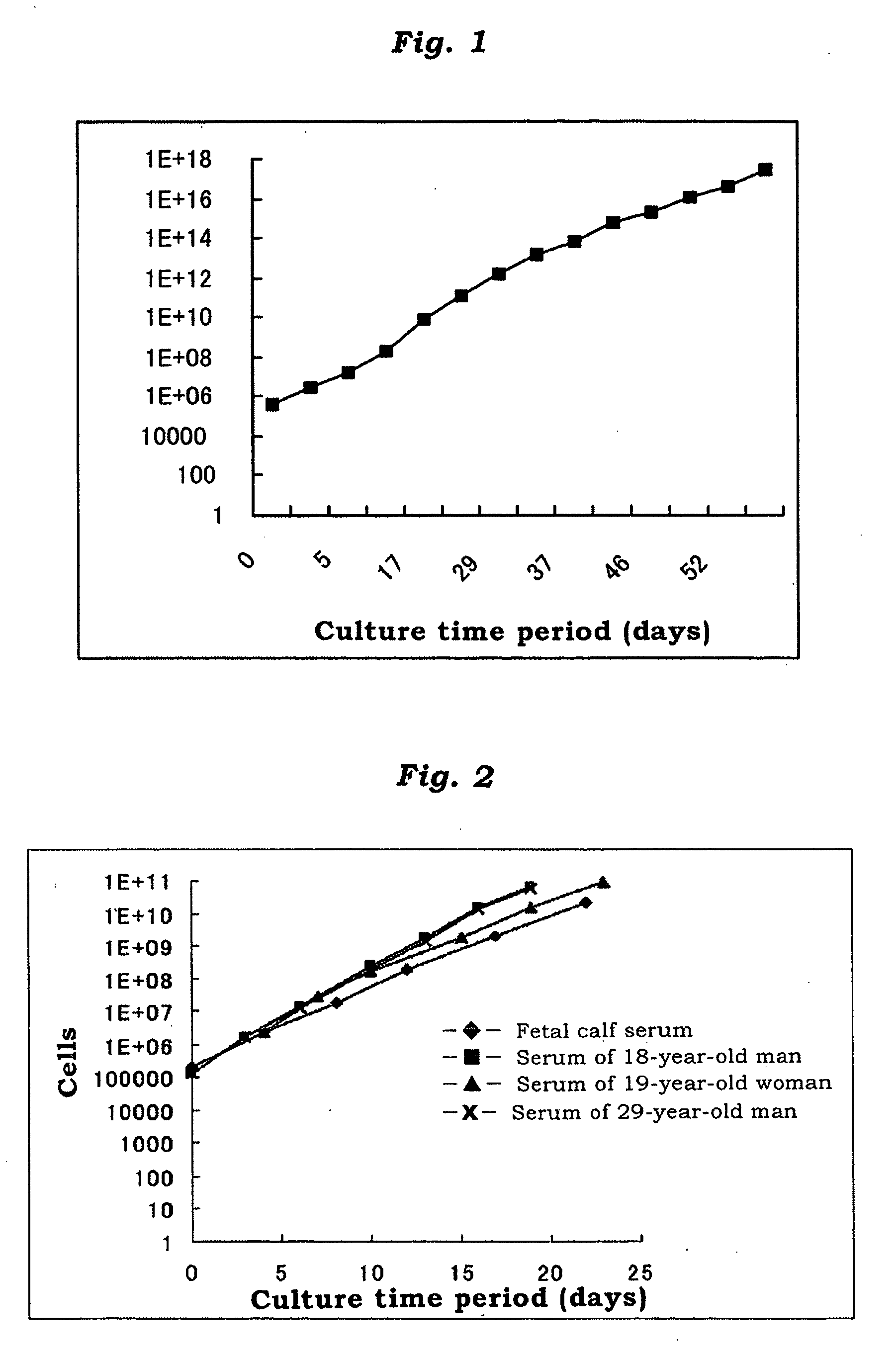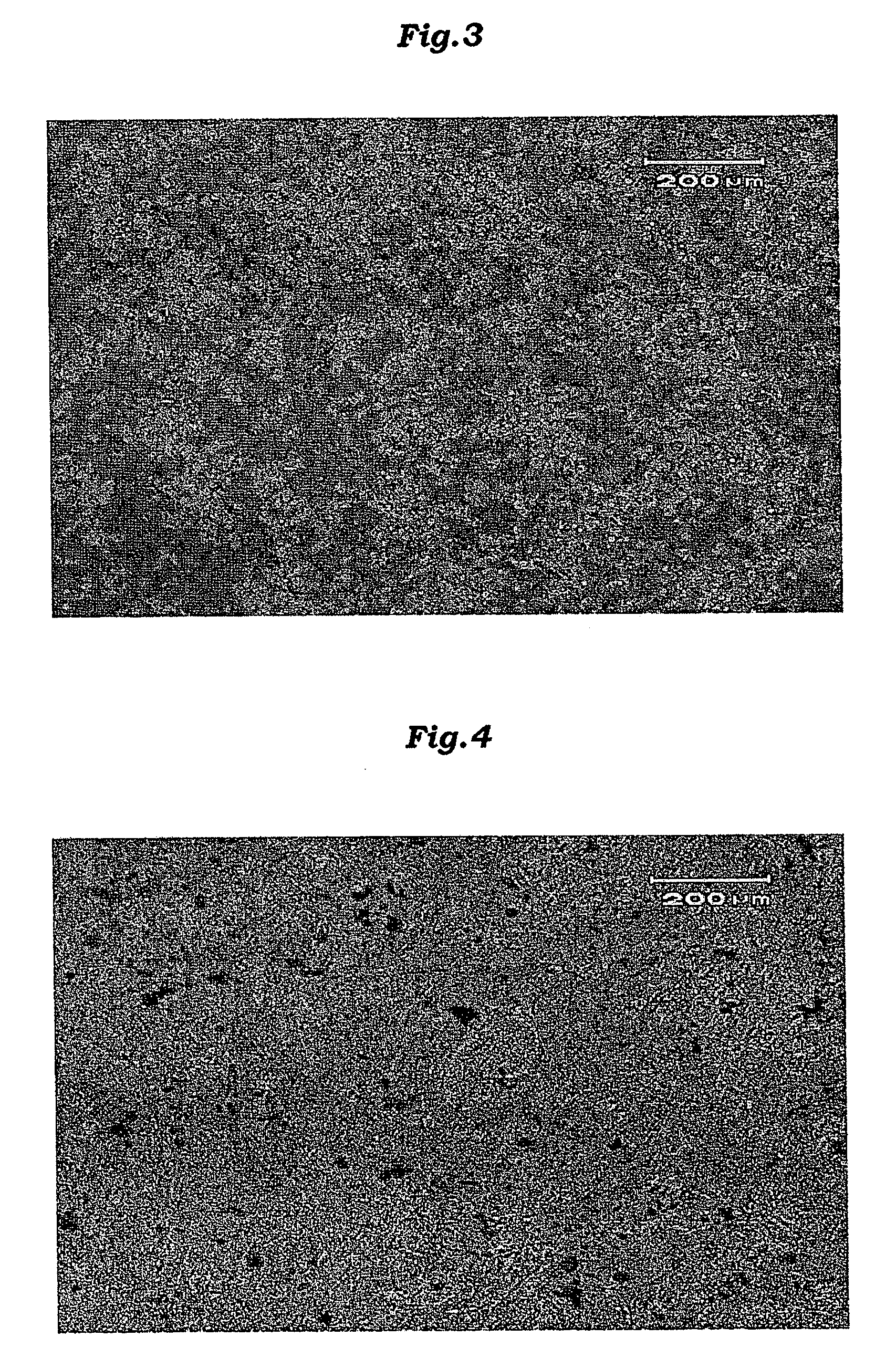Pluripotent Cells Distributed Ubiquitously In Animal Tissue, Which Proliferate Selectively In Lower-Serum Culture
a technology of pluripotent cells and animal tissue, applied in the field of pluripotent cells, can solve the problems of requiring a large amount of time and labor for expanding the culture volume of pluripotent cells, and achieve the effect of reducing the volume of transplantation
- Summary
- Abstract
- Description
- Claims
- Application Information
AI Technical Summary
Benefits of technology
Problems solved by technology
Method used
Image
Examples
example 1
Preparation of A Low Serum Medium Suitable To Culture of the Stem Cells Contained In Adipose Tissues
[0067] In the primary culture of the cells, a low serum medium was used, which was prepared by adding 1 / 100 part of linoleic acid-albumin (SIGMA) and 100 ×ITS supplement (SIGMA), 0.1 mmol / L of ascorbic acid phosphate ester magnesium salt n hydrate (Wako Pure Chemical Ind.), 50 U / ml of penicillin (Meiji Seika Kaisha, Ltd.), and 50 μg / ml of streptomycin (Meiji Seika Kaisha, Ltd.) to a 3:2 mixture of Dulbecco's modified Eagle's medium (Nissui Pharmaceutical Co., Ltd.) and MCDB201 medium (SIGMA) to give a serum-free basal medium, then adding 2% (v / v) fetal calf serum (ICN Biomedical Inc.) thereto, and further adding 20 ng / ml of human FGF-2 (PeproTech EC Inc.).
example 2
Preparation of Adipose Tissue-Derived Stem Cells By Low Serum Culture
[0068] From a 22-year-old male patient with his informed consent, subcutaneous adipose tissue (1.2 g) at the back normal part which was a residue of operation was recovered. This was washed with a equal volume mixture of Dulbecco's modified Eagle's medium and Ham's F12 medium (Nissui Pharmaceutical Co., Ltd.)(DMEM / F12 medium) to remove adhering blood and others. The adipose tissue was cut with a pair of surgical scissors into square pieces of 2 mm in size, to which was added 2.4 ml of 1 mg / ml collagenase solution (collagenase type I, WORTHINGTON), and the mixture was shaken at 37° C. for 1 hour. Thus treated solution was filtered through a steel mesh (250 μm pore size) to remove tissue pieces not digested with collagenase. The cell suspension was centrifuged at 1200 rpm at room temperature for 5 minutes to give a sedimented cell population as precipitate (SVF fraction). The SVF fraction was washed 3 times with DME...
example 3
Subculture of the Stem Cells Selected By Low Serum Culture
[0070] The cells grown immediately before a confluent state in Example 2 was washed with 1 mmol / L EDTA (Wako Pure Chemical Industries Inc.) / phosphate buffered physiological saline (Nissui Pharmaceutical Co., Ltd.), to which was added 0.25% (w / v) trypsin solution (SIGMA), and the mixture was incubated for 2 minutes so that the cells were peeled off. Fresh low serum medium was added, and the cells were dispersed therein and stained by a Türk's solution to count the number of cells. The cells (2×105) were inoculated in a fresh 25 cm2 flask coated with human fibronectin and cultured at 37° C. in 5% CO2 / 95% air saturated condition. The culture medium was changed with fresh low serum medium every 2 days.
[0071]FIG. 1 shows the results. That is, after 13 subcultures over 52 days, the cells were counted to proliferate up to 1018 cells (FIG. 1). This high proliferation ability indicates that these cells have on average of 40 cycles o...
PUM
| Property | Measurement | Unit |
|---|---|---|
| length | aaaaa | aaaaa |
| width | aaaaa | aaaaa |
| width | aaaaa | aaaaa |
Abstract
Description
Claims
Application Information
 Login to View More
Login to View More - R&D
- Intellectual Property
- Life Sciences
- Materials
- Tech Scout
- Unparalleled Data Quality
- Higher Quality Content
- 60% Fewer Hallucinations
Browse by: Latest US Patents, China's latest patents, Technical Efficacy Thesaurus, Application Domain, Technology Topic, Popular Technical Reports.
© 2025 PatSnap. All rights reserved.Legal|Privacy policy|Modern Slavery Act Transparency Statement|Sitemap|About US| Contact US: help@patsnap.com



